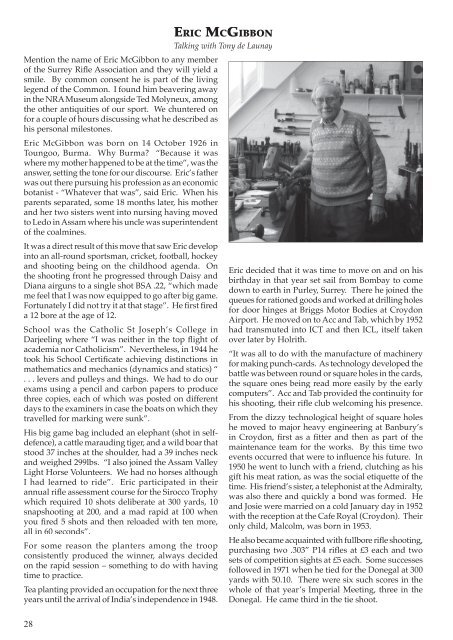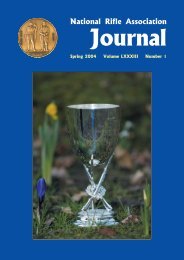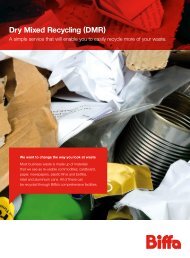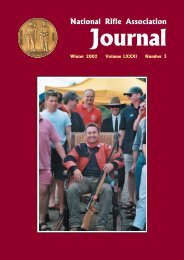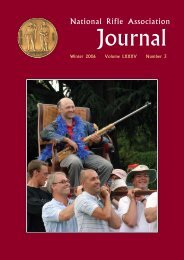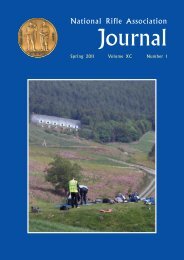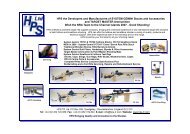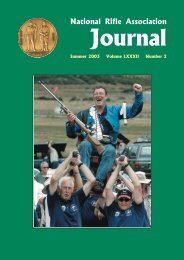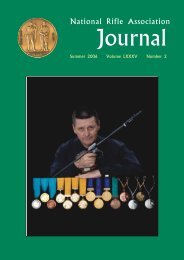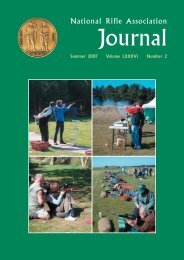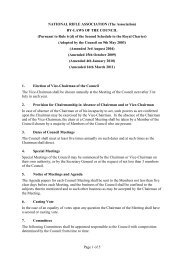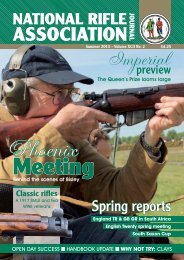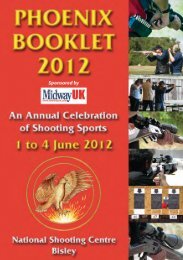NRA Journal - Spring 2007 - National Rifle Association
NRA Journal - Spring 2007 - National Rifle Association
NRA Journal - Spring 2007 - National Rifle Association
- No tags were found...
You also want an ePaper? Increase the reach of your titles
YUMPU automatically turns print PDFs into web optimized ePapers that Google loves.
Mention the name of Eric McGibbon to any memberof the Surrey <strong>Rifle</strong> <strong>Association</strong> and they will yield asmile. By common consent he is part of the livinglegend of the Common. I found him beavering awayin the <strong>NRA</strong> Museum alongside Ted Molyneux, amongthe other antiquities of our sport. We chuntered onfor a couple of hours discussing what he described ashis personal milestones.Eric McGibbon was born on 14 October 1926 inToungoo, Burma. Why Burma? “Because it waswhere my mother happened to be at the time”, was theanswer, setting the tone for our discourse. Eric’s fatherwas out there pursuing his profession as an economicbotanist - “Whatever that was”, said Eric. When hisparents separated, some 18 months later, his motherand her two sisters went into nursing having movedto Ledo in Assam where his uncle was superintendentof the coalmines.It was a direct result of this move that saw Eric developinto an all-round sportsman, cricket, football, hockeyand shooting being on the childhood agenda. Onthe shooting front he progressed through Daisy andDiana airguns to a single shot BSA .22, “which mademe feel that I was now equipped to go after big game.Fortunately I did not try it at that stage”. He first fireda 12 bore at the age of 12.School was the Catholic St Joseph’s College inDarjeeling where “I was neither in the top flight ofacademia nor Catholicism”. Nevertheless, in 1944 hetook his School Certificate achieving distinctions inmathematics and mechanics (dynamics and statics) “. . . levers and pulleys and things. We had to do ourexams using a pencil and carbon papers to producethree copies, each of which was posted on differentdays to the examiners in case the boats on which theytravelled for marking were sunk”.His big game bag included an elephant (shot in selfdefence),a cattle marauding tiger, and a wild boar thatstood 37 inches at the shoulder, had a 39 inches neckand weighed 299lbs. “I also joined the Assam ValleyLight Horse Volunteers. We had no horses althoughI had learned to ride”. Eric participated in theirannual rifle assessment course for the Sirocco Trophywhich required 10 shots deliberate at 300 yards, 10snapshooting at 200, and a mad rapid at 100 whenyou fired 5 shots and then reloaded with ten more,all in 60 seconds”.For some reason the planters among the troopconsistently produced the winner, always decidedon the rapid session – something to do with havingtime to practice.Tea planting provided an occupation for the next threeyears until the arrival of India’s independence in 1948.ERIC MCGIBBONTalking with Tony de LaunayEric decided that it was time to move on and on hisbirthday in that year set sail from Bombay to comedown to earth in Purley, Surrey. There he joined thequeues for rationed goods and worked at drilling holesfor door hinges at Briggs Motor Bodies at CroydonAirport. He moved on to Acc and Tab, which by 1952had transmuted into ICT and then ICL, itself takenover later by Holrith.“It was all to do with the manufacture of machineryfor making punch-cards. As technology developed thebattle was between round or square holes in the cards,the square ones being read more easily by the earlycomputers”. Acc and Tab provided the continuity forhis shooting, their rifle club welcoming his presence.From the dizzy technological height of square holeshe moved to major heavy engineering at Banbury’sin Croydon, first as a fitter and then as part of themaintenance team for the works. By this time twoevents occurred that were to influence his future. In1950 he went to lunch with a friend, clutching as hisgift his meat ration, as was the social etiquette of thetime. His friend’s sister, a telephonist at the Admiralty,was also there and quickly a bond was formed. Heand Josie were married on a cold January day in 1952with the reception at the Cafe Royal (Croydon). Theironly child, Malcolm, was born in 1953.He also became acquainted with fullbore rifle shooting,purchasing two .303” P14 rifles at £3 each and twosets of competition sights at £5 each. Some successesfollowed in 1971 when he tied for the Donegal at 300yards with 50.10. There were six such scores in thewhole of that year’s Imperial Meeting, three in theDonegal. He came third in the tie shoot.28


